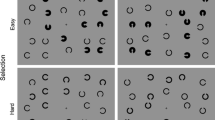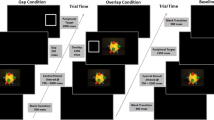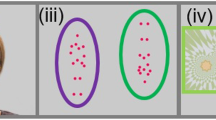Abstract
By using the gap overlap task, we investigated disengagement from faces and objects in children (9–17 years old) with and without autism spectrum disorder (ASD) and its neurophysiological correlates. In typically developing (TD) children, faces elicited larger gap effect, an index of attentional engagement, and larger saccade-related event-related potentials (ERPs), compared to objects. In children with ASD, by contrast, neither gap effect nor ERPs differ between faces and objects. Follow-up experiments demonstrated that instructed fixation on the eyes induces larger gap effect for faces in children with ASD, whereas instructed fixation on the mouth can disrupt larger gap effect in TD children. These results suggest a critical role of eye fixation on attentional engagement to faces in both groups.




Similar content being viewed by others
References
American Psychiatric Association. (1994). Diagnostic and statistical manual of mental disorders (4th ed.). Washington, DC: Author.
American Psychiatric Association. (2000). Diagnostic and statistical manual of mental disorders (DSM-IV-TR) (4th ed.). Washington: American Psychiatric Publishing, Inc.
Balaban, C. D., & Weinstein, J. M. (1985). The human pre-saccadic spike potential: Influences of a visual target, saccade direction, electrode laterality and instructions to perform saccades. Brain Research, 347, 49–57.
Bentin, S., Allison, T., Puce, A., Perez, E., & McCarthey, G. (1996). Electrophysiological studies of face perception in humans. Journal of Cognitive Neurosicence, 8, 551–565.
Berument, S. K., Rutter, M., Lord, C., Pickles, A., & Bailey, A. (1999). Autism screening questionnaire: Diagnostic validity. British Journal of Psychiatry, 175, 444–451.
Bindemann, M., Burton, A. M., Hooge, I. T., Jenkins, R., & de Haan, E. H. F. (2005). Faces retain attention. Psychonomic Bulletin & Review, 12, 1048–1053.
Boraston, Z. L., Corden, B., Miles, L. K., Skuse, D. H., & Blakemore, S. (2008). Brief report: Perception of genuine and posed smiles by individuals with autism. Journal of Autism and Developmental Disorders, 38, 574–580.
Brooks-Eidelberg, B. A., & Adler, G. (1992). A frontal cortical potential associated with saccades in humans. Experimental Brain Research, 89, 441–446.
Bruce, V. (1988). Recognising faces. Hillsdale, NJ: Erlbaum.
Chawarska, K., Klin, A., & Volkmar, F. (2003). Automatic attention cueing through eye movement in 2-year old children with autism. Child Development, 74, 1108–1122.
Chawarska, K., & Shic, F. (2009). Looking but not seeing: Atypical visual scanning and recognition of faces in 2 and 4-year-old children with autism spectrum disorder. Journal of Autism and Developmental Disorders, 39, 1663–1672.
Chawarska, K., Volkmar, F., & Klin, A. (2010). Not a captive audience: attentional abnormalities in response to novel faces in toddlers with ASD. Archives of General Psychiatry, 67, 178–185.
Csibra, G., Johnson, M. H., & Tucker, L. A. (1997). Attention and oculomotor control: A high-density ERP study of the gap effect. Neuropsychologia, 35, 855–865.
Csibra, G., Tucker, L. A., & Johnson, M. H. (1998). Neural correlates of saccade planning in infants: A high-density ERP study. International Journal of Psychophysiology, 29, 201–215.
Csibra, G., Tucker, L. A., Volein, Á., & Johnson, M. H. (2000). Cortical development and saccade planning: The ontogeny of the spike potential. Neuro Report, 11, 1069–1073.
Dairoku, H., Senju, A., Hayashi, E., Tojo, Y., & Ichikawa, H. (2004). Development of Japanese version of autism screening questionnaire. Kokuritsu Tokushu Kyoiku Sougou Kenkyusho Bunshitsu Ippan Kenkyu Houkokusho, B-184, 19–34.
Dalton, K. M., Nacewicz, B. M., Johnstone, T., Schaefer, H. S., Gernsbacher, M. A., Goldsmith, H. H., et al. (2005). Gaze fixation and the neural circuitry of face processing in autism. Nature Neuroscience, 8, 519–526.
Dapretto, M., Davies, M., Pfeifer, J. H., Scott, A. A., Sigman, M., Bookhimer, S. Y., et al. (2006). Understanding emotions in others: Mirror neuron dysfunction in children with autism spectrum disorders. Nature Neuroscience, 9, 28–30.
Dias, E. C., & Bruce, C. J. (1994). Physiological correlate of fixation disengagement in the primate’s frontal eye field. Journal of Neurophysiology, 72, 2532–2537.
Eimer, M. (1998). Does the face-specific N170 component reflect the activity of a specialized eye processor? Neurological Report, 9, 2945–2948.
Elsabbagh, M., Volein, A., Holmboe, K., Tucker, L., Csibra, G., Baron-Cohen, S., et al. (2009). Visual orienting in the early broader autism phenotype: Disengagement and facilitation. Journal of Child Psychology and Psychiatry, 50, 637–642.
Fischer, B., & Weber, H. (1993). Express saccades and visual attention. Behavioral and Brain Sciences, 16, 553–610.
George, N., Evans, J., Fiori, N., Davidoff, J., & Renault, B. (1996). Brain events related to normal and moderately scrambled faces. Cognitive Brain Research, 4, 65–76.
Goldberg, M. C., Lasker, A. G., Zee, D. S., Garth, E., Tien, A., & Landa, R. J. (2002). Deficits in the initiation of eye movements in the absence of a visual target in adolescents with high functioning autism. Neuropsychologia, 40, 2039–2049.
Gómez, C., Atienza, M., Gómez, G. J., & Vázquez, M. (1996). Response latencies and event-related potentials during the gap paradigm using saccadic responses in human subjects. International Journal of Psychophysiology, 23, 91–99.
Hadjikhani, N., Joseph, R. M., Snyder, J., Chabris, C. F., Clark, J., Steele, S., et al. (2004). Activation of the fusiform gyrus when individuals with autism spectrum disorder view faces. Neuroimage, 22, 1141–1150.
Hadjikhani, N., Josephe, R. M., Snyder, J., & Tager-Flusberg, H. (2007). Abnormal activation of the social brain during face perception in autism. Human Brain Mapping, 28, 441–449.
Humphreys, G. W., Hodsoll, J., & Campbell, C. (2005). Attending but not seeing: The “other race” effect in face and person perception studied through change blindness. Visual Cognition, 12, 249–262.
Itier, R., & Batty, M. (2009). Neural bases of eye and gaze processing: The core of social cognition. Neuroscience and Biobehavioral Reviews, 33, 843–863.
Japanese WISC-III Publication Committee. (1998). Nihonban WISC-III chinou kensahou (Japanese Wechsler Intelligence Scale for Children (3rd ed.). Tokyo: Nihon Bunka Kagakusha.
Jemel, B., Mottorn, L., & Dawson, M. (2006). Impaired face processing in autism: Face or artifact? Journal of Autism and Developmental Disorders, 36, 91–106.
Johnson, M. H. (2005). Subcortical face processing. Nature Neuroscience, 6, 766–774.
Jones, W., Carr, K., & Klin, A. (2008). Absence of preferential looking to the eyes of approaching adults predicts level of social disability in 2-year-old toddlers with autism spectrum disorder. Archives of General Psychiatry, 65, 946–954.
Junchöfer, M., Elbert, T., Tucker, D. M., & Rockstroh, B. (2000). Statistical control of artefacts in sense array EEG/MEG studies. Psychophysiology, 37, 523–532.
Kawakubo, Y., Kasai, K., Okazaki, S., Hosokawa-Kakurai, M., Watanabe, K., Kuwabara, H., et al. (2007). Electrophysiological abnormalities of spatial attention in adults with autism during the gap overlap task. Clinical Neurophysiology, 118, 1464–1471.
Kawakubo, Y., Maekawa, H., Itoh, K., Hashimoto, O., & Iwanami, A. (2004). Spatial attention in individuals with pervasive developmental disorders using the gap overlap task. Psychiatry Research, 125, 269–275.
Kemner, C., Schuller, A.-M., & van Engeland, H. (2006). Electrocortical reflections of face and gaze processing in children with pervasive developmental disorder. Journal of Child Psychology and Psychiatry, 47, 1063–1072.
Klin, A., Jones, W., Schultz, R., Volkmar, F., & Cohen, D. (2002). Visual fixation patterns during viewing of naturalistic social situations as predictors of social competence in individuals with autism. Archives of General Psychiatry, 59, 809–816.
Kurtzberg, D., & Vaughan, H. G., Jr. (1982). Topographic analysis of human cortical potentials preceding self-initiated and visually triggered saccades. Brain Research, 243, 1–9.
Kylliäinen, A., & Hietanen, J. K. (2006). Skin conductance responses to another person’s gaze in children with autism. Journal of Autism and Developmental Disorders, 36, 517–525.
Landry, R., & Bryson, S. E. (2004). Impaired disengagement of attention in young children with autism. Journal of Child Psychology and Psychiatry, 45, 1115–1122.
Langton, S. R. H., Law, A. S., Burton, A. M., & Schweinberger, S. R. (2008). Attention capture by faces. Cognition, 107, 330–342.
Matsumoto, D., & Ekman, P. (1988). Japanese and Caucasian neutral faces (JACNeuF) [CD]. San Francisco: San Francisco State University.
McPartland, J., Dawson, G., Webb, S. J., Panagiotides, H., & Carver, L. J. (2004). Event-related brain potentials reveal anomalies in temporal processing of faces in autism spectrum disorder. Journal of Child Psychology and Psychiatry, 45, 1235–1245.
Morris, J. P., Pelphrey, K. A., & McCarthy, G. (2007). Controlled scanpath variation alters fusiform face activation. Social Cognitive and Affective Neuroscience, 2, 31–38.
Munoz, D. P., & Everlaing, S. (2004). Look away: The anti-saccade task and the voluntary control of eye movement. Nature Neurosicence, 5, 218–228.
Munoz, D. P., & Wurtz, R. H. (1992). Role of the rostal superior colliculus in active visual fixation and execution of express saccades. Journal of Neurophysiology, 63, 1417–1428.
Nacewicz, B. M., Dalton, K. M., Johnstone, T., Long, M. T., McAuliff, E. M., Oakes, T. R., et al. (2006). Amygdala volume and nonverbal social impairment in adoloscent and adult males with autism. Archives of General Psychiatry, 59, 809–816.
Nation, K., & Penny, S. (2008). Sensitivity to eye gaze in autism: Is it normal? Is it automatic? Is it social? Development and Psychopathology, 20, 79–97.
Norbury, C. F., Brock, J., Cragg, L., Einav, S., Griffiths, H., & Nation, K. (2009). Eye-movement patterns are associated with communicative competence in autistic spectrum disorders. Journal of Child Psychology and Psychiatry, 50, 834–842.
O’Connor, K., Hamm, J. P., & Kirk, I. J. (2005). The neurophysiological correlates of face processing in adults and children with Asperger’s syndrome. Brain and Cognition, 59, 82–95.
O’Connor, K., Hamm, J. P., & Kirk, I. J. (2007). Neurophysiological responses to face, facial regions, and objects in adults with Asperger’s syndrome: An ERP investigateion. International Journal of Psychophysiology, 63, 283–293.
Osterling, J. A., Dawson, G., & Munson, J. A. (2002). Early recognition of 1-year-old infants with autism spectrum disorder versus mental retardation. Development and Psychopathology, 14, 239–251.
Palermo, R., & Rhodes, G. (2003). Change detection in the flicker paradigm: Do faces have an advantage? Visual Cognition, 10, 683–713.
Pelphrey, K. A., Sasson, N. J., Reznick, J. S., Paul, G., Goldman, B. D., & Piven, J. (2002). Visual scanning of faces in autism. Journal of Autism and Developmental Disorders, 32, 249–261.
Posner, M. I., Walker, J. A., Friedrich, F. J., & Rafal, R. D. (1984). Effects of parietal injury on covert orienting of attention. The Journal of Neuroscience, 4, 1863–1874.
Ro, T., Friggel, A., & Lavie, N. (2007). Attentional biases for faces and body parts. Visual Cognition, 15, 322–348.
Ro, T., Russell, C., & Lavie, N. (2001). Changing faces: A detection advantage in the flicker paradigm. Psychological Science, 12, 94–99.
Rutherford, M. D., & Towns, A. M. (2008). Scan path differences and similarities during emotion perception in those with and without autism spectrum disorders. Journal of Autism and Developmental Disorders, 38, 1371–1381.
Saslow, M. G. (1967). Effects of components of displacement step stimuli upon latency for saccadic eye movements. Journal of Optical Society of America, 57, 1024–1029.
Sasson, N. J. (2006). The development of face processing in autism. Journal of Autism and Developmental Disorders, 36, 381–394.
Senju, A., & Johnson, M. H. (2009a). Atypical eye contact in autism: Models, mechanisms and development. Neuroscience and Biobehavioral Reviews, 33, 1204–1214.
Senju, A., & Johnson, M. H. (2009b). The eye contact effect: Mechanisms and development. Trends in Cognitive Sciences, 13, 127–134.
Simons, D. J., & Rensink, R. A. (2005). Change blindness: Past, present, and future. Trends in cognitive Sciences, 9, 16–20.
Sterling, L., Dawson, G., Webb, S., Murias, M., Munson, J., Panagiotides, H., et al. (2008). The role of face familiarity in eye tracking of faces by individuals with autism spectrum disorders. Journal of Autism and Developmental Disorders, 38, 1666–1675.
Swettenham, J., Baron-Cohen, S., Charman, T., Cox, A., Baird, G., Drew, A., et al. (1998). The frequency and distribution of spontaneous attention shifts between social and non social stimuli in autistic, typically developing, and nonautistic developmentally delayed infants. Journal of Child Psychology and Psychiatry, 39, 747–753.
Taylor, M. J., Batty, M., & Itier, R. J. (2004). The faces of development: A review of early face processing over childhood. Journal of Cognitive Neuroscience, 16, 1426–1442.
Taylor, M. J., Itier, R. J., Allison, T., & Edmonds, G. E. (2001). Direction of gaze effects on early face processing: Eyes-only versus full faces. Cognitive Brain Research, 10, 333–340.
Theeuwes, J., & Van der Stigchel, S. (2006). Faces capture attention: Evidence from inhibition of return. Visual Cognition, 13, 657–665.
Van der Geest, J. N., Kemner, C., Camfferman, G., Verbaten, M. N., & van Engeland, H. (2001). Eye movements, visual attention and autism: A saccadic reaction time study using the gap and overlap paradigm. Biological Psychiatry, 50, 614–619.
Van der Geest, J. N., Kemner, C., Verbaten, M. N., & van Engeland, H. (2002). Gaze behavior of children with pervasive developmental disorder toward human faces: a fixation time study. Journal of Child Psychology and Psychiatry, 43, 449–478.
VanRullen, R. (2006). On second glance: Still no high-level pop-out effect for faces. Vision Research, 46, 3017–3027.
Wechsler, D. (1992). Wechsler intelligence scale for children (3rd ed.). London: Psychological Corporation.
Wojciulik, E., Kanwisher, N., & Driver, J. (1998). Covert visual attention modulates face-specific activity in the human fusiform gyrus: fMRI study. Journal of Neurophysiology, 79, 1574–1578.
Zwaigenbaum, L., Bryson, S., Rogers, T., Roberts, W., Brian, J., & Szatmari, P. (2005). Behavioral manifestations of autism in the first year of life. International Journal of Developmental Neuroscience, 23, 143–152.
Acknowledgments
We would like to acknowledge all the children, their parents and the teachers of Musashino Higashi Gakuen. We thank all of the staffs for their assistance in data collection and thank Monika Kiss for providing house stimuli, Katarzyna Chawarska and Gergely Csibra for comments on earlier version of drafts, Rie Fukumoto and all other members of Hasegawa Lab for their supports in testing. This study was supported by the Japan Society for the Promotion of Science (JSPS): Grant-in-Aid for JSPS Fellows (199041), JSPS: the 21st Century COE Program J05 “Center for Evolutionary Cognitive Sciences at the University of Tokyo” and JSPS: Grant-in-Aid for Scientific Research (B; 21330166) and (B; 19330210). AS was also supported by the ESRC Research Fellowship (RES-063-27-0207).
Author information
Authors and Affiliations
Corresponding author
Rights and permissions
About this article
Cite this article
Kikuchi, Y., Senju, A., Akechi, H. et al. Atypical Disengagement from Faces and Its Modulation by the Control of Eye Fixation in Children with Autism Spectrum Disorder. J Autism Dev Disord 41, 629–645 (2011). https://doi.org/10.1007/s10803-010-1082-z
Published:
Issue Date:
DOI: https://doi.org/10.1007/s10803-010-1082-z




